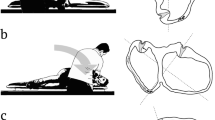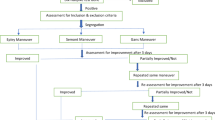Abstract
This retrospective study was conducted to determine the relationship between variable factors and the recurrence rate of post-semicircular canal benign paroxysmal positional vertigo (PSC-BPPV) after canalith repositioning procedure (CRP). Patients with PSC-BPPV were diagnosed by history and the presence of a positive Dix–Hallpike maneuver between 2008 and 2010. In total, 243 patients (47 males and 196 females, average age = 57.5 years) treated with Epley’s maneuver or canalith repositioning procedure (CRP) were included in the study. The demographic factors studied were age, sex, sleep disorders, inner ear diseases, head trauma history, and cardiovascular diseases. Multivariate statistics using SPSS version 15, Pearson’s Chi-squared test (χ 2), Kaplan–Meier analysis, log-rank test, and Cox proportional hazards regression model were used for the analysis. The success rate of vertigo control after the initial CRP was 83.1 %. Pearson’s χ 2 test results showed that females and participants with sleep disorders exhibited a significant difference in the recurrence of vertigo after the initial CRP. In addition, the Kaplan–Meier analysis and log-rank test survival analysis revealed that the recurrence was associated with females and participants with sleep disorders and inner ear diseases. However, Cox proportional hazards regression showed no differences in recurrences associated with old age, sex, sleep disorders, inner ear diseases, head trauma, and cardiovascular diseases. Epley’s maneuver or CRP is an effective, safe, and simple treatment for BPPV. Females and participants with sleep disorders and inner ear diseases are likely associated with the recurrence of BPPV after CRP.







Similar content being viewed by others
References
Dlugaiczyk J et al (2011) Involvement of the anterior semicircular canal in posttraumatic benign paroxysmal positioning vertigo. Otol Neurotol 32(8):1285–1290
Whitney SL, Marchetti GF, Morris LO (2005) Usefulness of the dizziness handicap inventory in the screening for benign paroxysmal positional vertigo. Otol Neurotol 26(5):1027–1033
Fife TD et al (2008) Practice parameter: therapies for benign paroxysmal positional vertigo (an evidence-based review): report of the quality standards subcommittee of the American academy of neurology. Neurology 70(22):2067–2074
Steenerson RL, Cronin GW, Marbach PM (2005) Effectiveness of treatment techniques in 923 cases of benign paroxysmal positional vertigo. Laryngoscope 115(2):226–231
Herdman SJ (1997) Advances in the treatment of vestibular disorders. Phys Ther 77(6):602–618
Furman JM, Cass SP (1999) Benign paroxysmal positional vertigo. N Engl J Med 341(21):1590–1596
Nunez RA, Cass SP, Furman JM (2000) Short- and long-term outcomes of canalith repositioning for benign paroxysmal positional vertigo. Otolaryngol Head Neck Surg 122(5):647–652
Monobe H, Sugasawa K, Murofushi T (2001) The outcome of the canalith repositioning procedure for benign paroxysmal positional vertigo: are there any characteristic features of treatment failure cases? Acta Otolaryngol Suppl 545:38–40
Hamid M (2010) Medical management of common peripheral vestibular diseases. Curr Opin Otolaryngol Head Neck Surg 18(5):407–412
Korres SG et al (2007) Benign paroxysmal positional vertigo and its management. Med Sci Monit 13(6):CR275–CR282
Gordon CR et al (2004) Is posttraumatic benign paroxysmal positional vertigo different from the idiopathic form? Arch Neurol 61(10):1590–1593
Dornhoffer JL, Colvin GB (2000) Benign paroxysmal positional vertigo and canalith repositioning: clinical correlations. Am J Otol 21(2):230–233
Sakaida M et al (2003) Long-term outcome of benign paroxysmal positional vertigo. Neurology 60(9):1532–1534
Imai T et al (2005) Natural course of the remission of vertigo in patients with benign paroxysmal positional vertigo. Neurology 64(5):920–921
Lin HC et al (1999) The canalith repositioning procedure for benign paroxysmal positional vertigo. J Taiwan Otolaryngol Head Neck Surg 34(5):379–384
Levrat E et al (2003) Efficacy of the Semont maneuver in benign paroxysmal positional vertigo. Arch Otolaryngol Head Neck Surg 129(6):629–633
Seo T et al (2007) Immediate efficacy of the canalith repositioning procedure for the treatment of benign paroxysmal positional vertigo. Otol Neurotol 28(7):917–919
Radtke A et al (2004) Self-treatment of benign paroxysmal positional vertigo: Semont maneuver vs Epley procedure. Neurology 63(1):150–152
Oh HJ et al (2007) Predicting a successful treatment in posterior canal benign paroxysmal positional vertigo. Neurology 68(15):1219–1222
Brandt T et al (2006) Benign paroxysmal positioning vertigo: a long-term follow-up (6–17 years) of 125 patients. Acta Otolaryngol 126(2):160–163
Bhattacharyya N et al (2008) Clinical practice guideline: benign paroxysmal positional vertigo. Otolaryngol Head Neck Surg 139(5 Suppl 4):S47–S81
Cohen HS, Kimball KT (2005) Effectiveness of treatments for benign paroxysmal positional vertigo of the posterior canal. Otol Neurotol 26(5):1034–1040
Lee NH et al (2010) Benign paroxysmal positional vertigo secondary to inner ear disease. Otolaryngol Head Neck Surg 143(3):413–417
Gross EM et al (2000) Intractable benign paroxysmal positional vertigo in patients with Meniere’s disease. Laryngoscope 110(4):655–659
Author information
Authors and Affiliations
Corresponding author
Ethics declarations
Conflicts of interest
All authors including Peijen Su, Yun-Chih Liu, Hung-Ching Lin, declare no conflict of interests. There is also no financial support for this study.
Ethical standard
The study was approved by the Mackay memorial hospital’s institutional review board (13MMHIS054) with chairman of Yen-Ta Lu M.D. PhD. All patients records/information were anonymized and de-identified prior to analysis.
Rights and permissions
About this article
Cite this article
Su, P., Liu, YC. & Lin, HC. Risk factors for the recurrence of post-semicircular canal benign paroxysmal positional vertigo after canalith repositioning. J Neurol 263, 45–51 (2016). https://doi.org/10.1007/s00415-015-7931-0
Received:
Revised:
Accepted:
Published:
Issue Date:
DOI: https://doi.org/10.1007/s00415-015-7931-0




